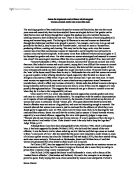Men are convicted of more crime than women. Men are suspected, charged and convicted of crime of all types more than women this pattern crosses all other social factors such as age, class, ethnicity and region. The subcultures theories of Miller (1962) and Merton (1968) argue that the culture and lifestyles of young men encourage and lead to crime (remember, most crime is committed by the young). Heidensohn (1986) says gender socialization prompts men to be more aggressive which makes them more likely than women to commit violent crime. She also says that women are socialized into not being criminal. In the same way as men are socialized into seeing criminal activity as acceptable. Abbott and Wallace (1990) argue young women are more closely watched by their families and given less freedom outside the home, reducing their opportunities for crime. Criminal behavior would be seen as highly deviant as well as criminal for women. Ian Marsh (1986) reckons that men commit more crime because they have more opportunities to do so. He said that where females have similar opportunities to males they seem as likely to break laws. An example of this is handling stolen goods - women have more opportunity to sell, buy or use stolen property than to steal goods In the first place.
There may be an underestimation of female crime because the police and courts are less likely to suspect women or give women a custodial sentence. The stereotypes of men as criminal work as a form of sexism against men, which allows female criminal activity to go unchecked. Campbell (1981) did a self-report survey which unearthed a lot more female crime than the official statistics. However, she did include more trivial crimes than the official statistics do
Urban areas have much more crime than rural ones. In 2003-2004, Metropolitan (urban) police forces recorded 43% of all crime. In 2002, less than 2% of people living In rural areas became victims of burglary. In 2003-2004, 60% of all robbery In the UK took place In 3 urban areas: Manchester, London and west midlands. There's more crime In cities - Sociologists argue most crime takes place In cities because there are more opportunities, higher density populations which mean more chances for robbery and property crime. Most young people live in urban areas and they are the most likely to commit crime. It's hard for criminals to remain anonymous. In close-knit rural communities most criminal convictions are of people with a working class background.
There are more working class people in prison than any other social class. Home office figures also show that the majority of people who altar in court are working class, regardless of whether they're found guilty or not. Sub-cultural theorists such as Miller argue this reflects the working class sub-cultures which often have crime as an accepted or rewarded activity.
Marxists argue the system of law and order is run by the ruling class, against the Interests of the working class. They say parts of the working class are criminalized by a biased system. Middle class crime is treated more leniently by society. Fraud and white collar crime is often undetected and seen as ‘victimless crime' by the public. Consider public response to benefit fraud compared to tax or Insurance fraud.
Ethnicity
Seeing 2001 census and the Home office statistics on Race and the criminal justice system (2004) some have argued that police racism results in higher suspicion against black people. In general The Macpherson Report (1999) concluded that the police were institutionally racist. The court system has also been accused of automatically favoring white middle class defendants. There are few black people in either the police force or the legal system. Hall et al (1978) and Gilroy (1987) argue that young black people have been labeled as criminal by modern British society and have become a scapegoat for social problems in society.
Hall also says that high levels of unemployment among young black men lead some young black men to opt out of mainstream society and turn to crime.
New Right sociologists favor a subcultures explanation for the differences. Ethnic minority households are more at risk of crime than other households. E.g. the British crime Survey says they’re more likely to be mugged than white groups, and slightly more likely to be victims of vehicle theft. Pakistanis and Bangladeshis were more likely to be burgled. The survey found ethnic minority respondents were more worried about crime in 2000 than white respondents (2004 only 23 of reported crimes in 2003 were solved) – i.e. someone was convicted for the offence in 2003 (2004 social Trends). The social profile of who committed the unsolved and undetected crimes could change these patterns considerably.








